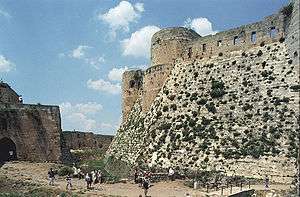Talus
Talus may refer to:
See also

Talus bone
The talus bone (/ˈteɪləs/; Latin for ankle), astragalus /əˈstræɡələs/, or ankle bone is one of the group of foot bones known as the tarsus. The tarsus forms the lower part of the ankle joint through its articulations with the lateral and medial malleoli of the two bones of the lower leg, the tibia and fibula. Within the tarsus, it articulates with the calcaneus below and navicular in front within the talocalcaneonavicular joint. Through these articulations, it transmits the entire weight of the body to the foot.
The second largest of the tarsal bones, it is also one of the bones in the human body with the highest percentage of its surface area covered by articular cartilage. Additionally, it is also unusual in that it has a retrograde blood supply, i.e. arterial blood enters the bone at the distal end.
In humans, no muscles attach to the talus, unlike most bones, and its position therefore depends on the position of the neighbouring bones.
Structure
Though irregular in shape, the talus can be subdivided into three parts.

Talus (fortification)
The talus is an architectural feature of some late medieval castles, especially prevalent in crusader constructions. It consists of a battered (sloping) face at the base of a fortified wall. The slope acts as an effective defensive measure in two ways. First, conventional siege equipment is less effective against a wall with a talus. Scaling ladders may be unable to reach the top of the walls and are also more easily broken due to the bending stresses caused by the angle they are forced to adopt. Siege towers cannot approach closer than the base of the talus, and their gangplank may be unable to cover the horizontal span of the talus, rendering them useless. Furthermore, defenders are able to drop rocks over the walls, which will shatter on the talus, spraying a hail of shrapnel into any attackers massed at the base of the wall.
See also
References
Further reading

Fracture
A fracture is the separation of an object or material into two or more pieces under the action of stress. The fracture of a solid usually occurs due to the development of certain displacement discontinuity surfaces within the solid. If a displacement develops perpendicular to the surface of displacement, it is called a normal tensile crack or simply a crack; if a displacement develops tangentially to the surface of displacement, it is called a shear crack, slip band, or dislocation.Fracture strength or breaking strength is the stress when a specimen fails or fractures.
The word fracture is often applied to bones of living creatures (that is, a bone fracture), or to crystals or crystalline materials, such as gemstones or metal. Sometimes, in crystalline materials, individual crystals fracture without the body actually separating into two or more pieces. Depending on the substance which is fractured, a fracture reduces strength (most substances) or inhibits transmission of light (optical crystals). A detailed understanding of how fracture occurs in materials may be assisted by the study of fracture mechanics.

Fracture (2004 film)
Fracture is a 2004 New Zealand film written and directed by Larry Parr and based on the novel by Maurice Gee. The film is set in Wellington and stars Kate Elliott, Jared Turner and Australian John Noble. The film was met with positive reviews and was the second highest grossing local film at the New Zealand box office in 2004 behind In My Father's Den.
Plot
A young solo mother (Elliott) loves her son and his needs are foremost, but she still has room in her heart for her very broken brother (Turner), even as her fundamentalist mother cruelly rejects her. But when the brother is responsible for a woman's broken neck, during his burglary of her house, families are changed as crisis amplifies and at times the young mother seems to be the only adult.
Cast
Tagline
A single crack can shatter everything.
Production
The film had originally been set for a 2003 release but was delayed during production by the dissolution of director Larry Parr's production company Kahukura Productions.

Bone fracture
A bone fracture (sometimes abbreviated FRX or Fx, Fx, or #) is a medical condition in which there is a damage in the continuity of the bone. A bone fracture can be the result of high force impact or stress, or a minimal trauma injury as a result of certain medical conditions that weaken the bones, such as osteoporosis, bone cancer, or osteogenesis imperfecta, where the fracture is then properly termed a pathologic fracture.
Although broken bone and bone break are common colloquialisms for a bone fracture, break is not a formal orthopedic term.
Signs and symptoms
Although bone tissue itself contains no nociceptors, bone fracture is painful for several reasons:
Podcasts:

